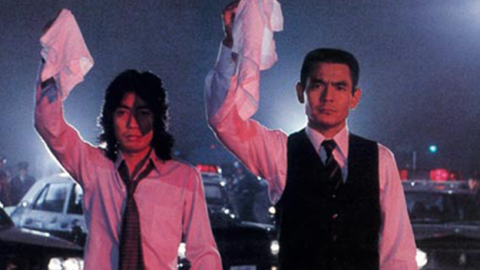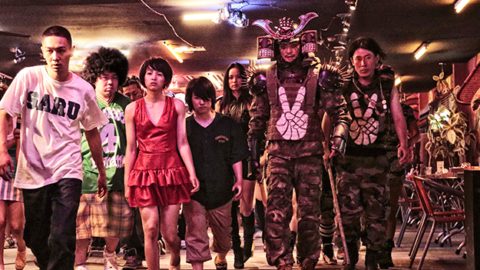NYAFF Interview: Daihachi Yoshida
In the late Nineties and early Aughts, two genres of Japanese film rose to prominence within Western cult-movie circles, thanks in large part to the Internet and DVDs: J-horror (The Ring, Pulse, Dark Water) and outlandish, absurd comedies (Welcome Back, Mr. McDonald, Happiness of the Katakuris). While J-horror would become an international phenomenon, feeding a cycle of Hollywood remakes (to say nothing of the wholesale stylistic pilfering that went on), only a handful of wacky Japanese comedies expanded to art-house audiences, because, well, that’s just the nature of their niche appeal. One such comedy was Daihachi Yoshida’s debut feature, Funuke Show Some Love, You Losers!.

Funuke Show Some Love, You Losers!
Premiering in Critics’ Week at Cannes, the 2007 film immediately put Yoshida on the map as a masterful practitioner of weird, dark comedy, after a start making TV commercials. In Funuke, the children of a couple who die while attempting to rescue a cat are forced to live under the same roof for the first time in years: dorky little sister Kyomi, an aspiring manga artist; sexy, psychotic older sister Sumika, an aspiring, talentless actress; half-brother Shinji, and his cheerful, long-suffering wife Machiko. While the roots of their feuds are peculiar and extreme—incest, dire debt, and prostitution—Sumika and Kyomi’s tumultuous relationship is the backbone of the story, and their bickering often reveals uncomfortable emotional truths about how sisters treat each other.
Daihachi has since demonstrated his talent for seamlessly moving between the wildly fanciful and the painfully real by adapting novels and manga like Kuhio Taisa (09), Permanent Nobara (10), and The Kirishima Thing (12). His newest, Pale Moon, fully departs from this approach with its adaptation of a Mitsuyo Kakuta novel. The sobering film tracks the fall of Rika Umezawa (Rie Miyazawa), a married bank employee in her thirties who begins embezzling from her elderly clients in order to splurge on her younger, college-dropout boyfriend. Set in 1994, shortly before Japan’s economic bubble burst (the title’s direct translation is “Paper Moon”), it’s a thoughtful study of the cruel ways in which capitalism, societal expectations for women in Japan, and carnal desire feed off one other.
FILM COMMENT spoke to Daihachi—whose future projects include adaptations of a “very famous Japanese novel” and a comic book—during his Filmmaker in Focus retrospective at the New York Asian Film Festival.

Pale Moon
A lot of your films are about women, specifically their place in society as well as their relationship to each other. What drew you to adapting Pale Moon?
I do agree that women are so much more attractive to me as a theme for films. Women have more social pressure in general, and I feel that women, as compared to men, think more deeply and take more actions because of that social pressure. In this festival, they’re showing three of my five films, but the remaining two that aren’t showing [The Kirishima Thing and The Wonderful World of Captain Kuhio] also feature women who are under social pressure, especially from the younger generation.
Did you draw on your own experiences from the “lost decade” while making aesthetic choices with Pale Moon?
When I entered society as a professional worker, the bubble had not burst yet in Japan. So I think in a way I was able to escape the immediate impact. Even after the bubble burst, I was still a young worker, so the influence on me was really minor. It’s the generation younger than me that experienced the full effect of the bubble bursting. I have a sense of guilt.
Did that sense of guilt translate into the aesthetics of your filmmaking? With Pale Moon, did you attempt to revive a Nineties-style of editing?
I particularly remember the thinness of the air after the bubble burst. Before, there was a lot of excitement and flamboyance and a glittering sense of ambiance. In terms of color, I remember everything being very pale, so I think that registered in the film as this cool, toned-down color aesthetic. And also, with regard to music, in my prior films I think there was a disjunction between the scenes and what the characters were feeling, but this time I used a more straightforward approach in that if the character was feeling happy or euphoric, I would put happier music and so on.

Pale Moon
You can see how Rika’s emotions shape her surroundings: by the end of the film, her once immaculate apartment is in complete disarray. From what I understand, the novel begins with her traveling to Thailand, but here it ends with her going to Thailand. Why did you decide not to use the “reflection” framework and tell it as a linear story?
In the novel, the story progresses through her monologue, looking back to what happened to her with the embezzlement, and we also hear accounts from past friends and lovers. So in that sense it’s fine to start with where she is in the present time. But I couldn’t do that for the film—I couldn’t start it with her in Thailand because that would be the conclusion. So I had to step back and make that decision, and in film it’s not really about the monologue, it’s about the action, so I had to show the action.
This is unlike your previous films like Funuke Show Some Love, You Losers! or Permanent Nobara because those two specifically move between this outlandish black comedy and melodrama. Specifically, I’m thinking of the scene in Permanent Nobara when the little girl gets her new bike. In that scene alone it switches between those two extremes multiple times. When you’re writing and filming, how do you make those transitions smooth?
Both consciously and subconsciously I think I feel that I always want to do something that I haven’t done before, but with that said, there are particular characteristics inherent to me that I cannot suppress that carry over to any films that I do. But when I was adapting Pale Moon from novel to film, I was really interested in portraying her process of embezzlement—every time her embezzlement increases, she becomes a little less free. The more happiness she claims, the more her struggle increases in an inverse relationship. In that dynamic, the element of humor did not necessarily fit in as in my previous works.
In your past films, it doesn’t feel forced—it’s very often painfully real.
I think the trick is not to try to make anyone laugh. You don’t write in the joke to make people laugh. What I firmly believe is that when a human being is earnest about something or very serious about something, there’s something humorous and funny about that for an audience. I think it’s all about calibrating the balance between laughter and the pressure and the struggle. So for Pale Moon, I think the percentage of the pressure of the struggle was emphasized far more than the laughter. I think that’s why a scene you would ordinarily find funny in my past work was not.

Permanent Nobara
Where did you get the ideas for the two other films that are showing in the New York Asian Festival, Funuke Show Some Love You Losers and Permanent Nobara? They’re very different, but they share a common thread of returning home, and the horror of that.
The truth is, for Funuke I read the novel first, and when I was reading it, I already had the movie in my head, I could imagine it, so I had the very basic impulse that I had to put that out. I think someone that saw Funuke approached me with the project for Permanent Nobara. But as you say, these two novels are 180-degree polar opposites, but it was also filtered through me, so of course there are common threads. But I think just because they were such different sources, it gave a nice variation to my career.
How was the process of adapting Permanent Nobara different than for Pale Moon?
For Permanent Nobara, the story takes place in the countryside, so I merely had to focus on the human relationships. The human relationships were at the forefront, and even though it was abstract, I could focus on delineating those emotions. But for Pale Moon, it was a little more difficult because the protagonist is so constrained by her profession, by the age that she lives in, and also her family. So in that sense, she’s a very contemporary protagonist, so I had to think far more deeply about her. So, to tell you truth, Pale Moon was a much more difficult process. In Permanent Nobara, it builds to this climax where it’s revealed that her lover was, in fact, dead. So in all of my films I feel that there’s a point of reversal, but because in Pale Moon there was no such point of reversal in the original novel, it took me quite a long time to find that. It ended up being that scene where she shatters the glass, of course, but to find that was a difficult process.
Was your choice to adapt Pale Moon influenced by recent political events in Japan, specifically the revised Security Agreement between the U.S. and Japan? Or just a sense of things becoming more conservative?
I don’t know if the political landscape influenced me, whether the Security Agreement or anything like that, but personally I do feel that Japanese society is closing in on me, and I do feel that pressure. This might sound a little irresponsible, but I think I make my female characters in my films triumph over those pressures and liberate themselves in a way that I cannot. I think that’s what was so symbolic about that glass-shattering scene. It’s something that I want to do, but cannot do in real life.





